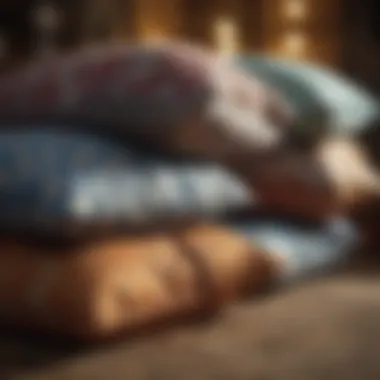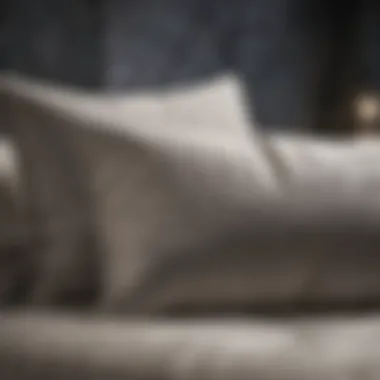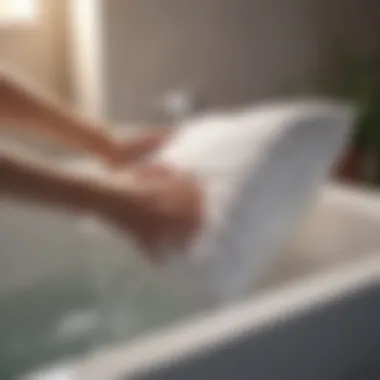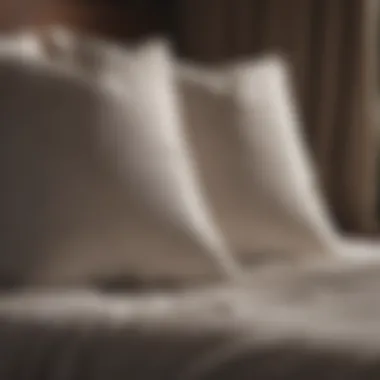The Ultimate Guide to Washing Throw Pillows Effectively


Intro
Throw pillows are a crucial element in home decor. They add comfort, color, and style to a room. However, over time, they can accumulate dust, allergens, and stains. Washing throw pillows can seem daunting due to the variety of materials and constructions. Understanding how to properly clean them is key to maintaining their look and extending their lifespan. In this article, we will explore various aspects of washing throw pillows, focusing on methods, materials, and maintenance strategies.
Importance of Cleaning Throw Pillows
Cleaning throw pillows is not just about aesthetics; it also involves hygiene. Throw pillows often serve as hosts for dust mites, pet dander, and other allergens. Thus, regular cleaning is essential for a healthy living environment. Moreover, well-maintained throw pillows can enhance the overall appeal of your interior spaces. When cleaning is done right, pillows can look and feel as good as new. This guide will help you navigate the cleaning process efficiently.
Understanding Fabric Care Labels
Each throw pillow comes with a care label that provides crucial information about its fabric and recommended cleaning methods. Understanding these labels is vital. The care label typically includes:
- Washing Instructions: Some can be machine washed, while others require hand washing or dry cleaning.
- Drying Instructions: This indicates how to properly dry the pillow after washing.
- Ironing Recommendations: Certain fabrics may tolerate ironing, and others may not.
"Reading and following the care label can prevent damage to your beloved throw pillows."
Failing to adhere to these guidelines can result in fading, shrinking, or deformation of the pillow. Make it a prioroty to examine these labels before proceeding with cleaning.
Types of Materials Used in Throw Pillows
Throw pillows are made from various materials, each requiring different care techniques. Common materials include:
- Cotton: Generally machine washable and dryer-safe, but can shrink.
- Polyester: Durable and often safe for machine washing.
- Silk: Requires dry cleaning due to its delicate nature.
- Linen: Machine washable but may wrinkle easily.
- Foam or Polyester Fill: Some fillers are not washable, so check the label.
Knowing the material helps in choosing the appropriate cleaning agents and methods.
Cleaning Methods
Cleaning methods vary based on the fabric and construction. Here are effective techniques:
Machine Washing
- Check the Care Label: Ensure the pillow case is machine washable.
- Remove Covers: If the pillow has a removable cover, take it off before washing.
- Use Cold Water: Set washing machine on a gentle cycle with cold water.
- Select a Mild Detergent: Avoid harsh chemicals that can damage the fabric.
- Dry on Low Heat: Once washed, dry the pillow on low heat to prevent shrinkage.
Hand Washing
- Fill a Tub with Water: Use lukewarm water and a small amount of mild detergent.
- Submerge the Pillow: Gently agitate the water to distribute the detergent.
- Rinse Thoroughly: Ensure all soap is removed to avoid residue.
- Squeeze Water Out: Do not wring; instead, press gently to remove water.
- Air Dry: Lay flat or hang to dry away from direct sunlight.
Spot Cleaning
For stains, spot cleaning might be sufficient. Use a damp cloth and mild detergent on the stained area, followed by a clean cloth to dab away moisture.
Maintaining the Shape and Freshness
After cleaning, it's essential to maintain the shape of your throw pillows. Here are some strategies:
- Fluff Regularly: Regularly puffing them up helps keep them looking full.
- Use Pillow Protectors: These can prevent dirt and allergens from reaching the fabric.
- Avoid Direct Sunlight: Prolonged exposure can lead to fading.
Understanding Throw Pillows and Their Materials
Throw pillows serve not only a decorative purpose but also contribute to the overall comfort of a space. Understanding the materials from which these pillows are made is crucial for successful cleaning and care. Each material has its own characteristics, durability, and cleaning requirements, which influence how they should be maintained. This section delves into the various materials used in throw pillows and their implications for cleaning methods.
Common Materials Used in Throw Pillows
Natural fibers
Natural fibers are derived from plants or animals, offering a distinct feel and aesthetic. Common examples include cotton, linen, and wool. One key characteristic of natural fibers is their breathability, which makes them comfortable and suitable for various settings. They are popular choices for those who favor sustainability and comfort in their home decor. However, they can be more susceptible to stains and may require special washing methods to prevent damage. Natural fibers usually promote a healthier indoor environment, but they also necessitate careful handling during cleaning due to potential shrinking or warping.
Synthetic fibers
Synthetic fibers, such as polyester and nylon, are man-made materials known for their durability and stain resistance. These fibers can withstand repeated washing without losing their shape. A significant benefit of synthetic fibers is that they can be more affordable compared to natural options. They also tend to dry faster, which is practical for maintenance. While synthetic fibers are robust, they might lack the breathability and softness found in natural options, making them less comfortable in some situations. Understanding these traits is vital when considering cleaning methods and the longevity of the pillows.
Blends and special finishes
Blends, which combine natural and synthetic fibers, often provide a balance of durability and comfort. For instance, a cotton-polyester blend might offer the softness of cotton with the resilience of polyester. Special finishes, such as water-repellent or stain-resistant treatments, enhance the cleaning properties and longevity of the pillows. These materials cater to consumers looking for functionality without compromising on style. However, special finishes may require specific cleaning approaches to maintain their efficacy, making it essential to understand the care instructions associated with these products.
Identifying Compatibility with Cleaning Methods
The compatibility of throw pillows with different cleaning methods heavily influences their maintenance. Recognizing whether a pillow is machine washable or if it requires hand washing or dry cleaning is important for their longevity.
Machine washable vs. hand wash only


Some pillows are designed to withstand machine washing, which is a convenient option for many. The key characteristic of machine washable pillows is that they are often constructed to handle the agitation and moisture of a washing machine. Nonetheless, many pillows are labeled as hand wash only due to delicate fabrics or unique construction. This distinction is crucial because incorrect washing methods can lead to irreversible damage. Machine washable pillows can save time, but they still require proper sorting and care to prevent unintentional harm.
Dry-clean only fabrics
Dry-clean only fabrics are typically associated with more delicate materials or specific finishes that cannot tolerate traditional washing methods. These fabrics maintain their structure and appearance through professional cleaning. A key characteristic of these materials is their limited compatibility with home cleaning methods, which could lead to shrinking or distortion if washed incorrectly. Understanding when to opt for dry cleaning is beneficial for maintaining the integrity of these pillows in the long term.
Water-resistant treatments
Water-resistant treatments are becoming increasingly popular for throw pillows, providing added protection against spills and stains. The primary advantage is their ease of cleaning, as many spills can simply be wiped away without a thorough wash. However, water-resistant finishes can diminish over time, especially if subjected to harsh cleaning methods. This characteristic makes it vital to follow manufacturer instructions closely. Maintaining water-resistant properties can enhance the pillow's lifespan, but awareness of how to care for such finishes is imperative.
Understanding the diverse materials used for throw pillows and their cleaning compatibility is essential for maintaining both their aesthetic and functional qualities. Careful attention to fabric care labels helps ensure longevity and cleanliness.
Preparation for Washing Throw Pillows
Preparation is a crucial step when washing throw pillows. It sets the stage for effective cleaning and helps prevent damage. Not all materials can withstand the same cleaning method. Without proper preparation, you risk ruining the aesthetic appeal and comfort of your pillows.
In this section, we discuss how to prepare effectively for washing. Focusing on fabric care labels and gathering necessary supplies is essential. These steps ultimately benefit cleaning results and maintain the pillow's integrity.
Checking Fabric Care Labels
Checking fabric care labels is vital. These labels provide specific instructions that help guide your cleaning process.
Understanding symbols and terminology
Understanding symbols and terminology helps decode the care requirements of different fabrics. Most labels include symbols like the washing machine icon, which indicates machine washability, and the triangle symbol, which points to bleaching options. Each symbol communicates a unique guideline, making adherence important for preserving the fabric’s condition.
The key characteristic of this section is the clarity it offers. Knowing these symbols makes choosing the proper cleaning methods easier. One significant advantage is that it reduces errors in cleaning, which can lead to irreversible damage. However, misinterpretation can happen if you do not familiarize yourself with these guidelines, potentially leading to unfortunate outcomes.
Following manufacturer's instructions
Following manufacturer's instructions ensures the pillow is cleaned correctly. Each pillow is unique, depending on materials and construction. Ignoring these instructions can lead to fading colors, shrinking, or even complete loss of shape.
The main characteristic here is specificity. These instructions often provide insights on water temperature, cleaning solutions, and drying techniques tailored for that specific pillow. This targeted approach is beneficial, as it minimizes the risk of damage or mishaps during the washing process. Conversely, neglecting these directions may mean less effective cleaning and a shorter lifespan for your pillow.
Gathering Necessary Supplies
Gathering necessary supplies plays a significant role in simplifying the cleaning process. Without the right tools and solutions, washing throw pillows can become challenging.
Cleaning solutions
Cleaning solutions are pivotal when maintaining cleanliness and hygiene. Choosing the right solution can enhance stain removal and protect the fabric. Many available options include gentle detergents, which are safe for most fabrics.
The key characteristic of a suitable cleaning solution is its effectiveness on various stains while being mindful of fabric types. A gentle detergent is a popular choice for its versatility; however, too strong of a cleaner can damage soft fibers. Thus, it's essential to select accordingly and consider any fabric-specific instructions.
Tools for hand washing and machine washing
Tools for hand washing and machine washing can significantly impact cleaning efficiency. Hand washing may require items like soft sponges and buckets, while machine washing needs laundry bags and appropriate cycles. Each method has its strengths.
The unique feature of these tools is their adaptability to different fabrics. Hand washing tools allow for more control over the process, making it a suitable choice for delicate materials. In contrast, which are designed specifically for machines increase convenience. However, improper use of either can result in fabric distress.
Protective gear
Protective gear may seem optional but is vital for safe cleaning. Using gloves can protect your hands from harsh chemicals that may be in some cleaning solutions. Moreover, wearing a mask can help if you are sensitive to dust or cleaning agents.
The key characteristic of protective gear is that it enhances safety. It is a prudent choice while cleaning not only for personal safety but also for maintaining hygiene. The unique feature is that it encourages more thorough cleaning by providing peace of mind. However, neglecting this aspect can lead to discomfort or allergic reactions during the cleaning process.
Machine Washing Throw Pillows
Machine washing throw pillows can be an efficient method to maintain their cleanliness and extend their lifespan. The benefits of machine washing are especially appealing to those with busy lifestyles. It allows for thorough cleaning without significant manual effort. However, careful consideration must be given to the type of material and the specific cleaning instructions that each pillow has. Not all pillows can withstand the rigors of a washing machine, and failing to recognize this can lead to damage.
Steps for Safe Machine Washing
Preparing pillows for washing
Preparing pillows for washing involves a few substantial steps that ensure the effectiveness of the process. This preparation includes checking for any visible stains and removing them before the actual wash. Fluffing and shaking the pillows can also help in redistributing the filling, ensuring a more even cleaning. This careful approach reduces potential clumping in the wash cycle. Overall, it enhances the chances of achieving a satisfying clean.
Selecting the right wash cycle
Selecting the right wash cycle can significantly impact the outcome of the washing process. Many pillows should be washed on a gentle cycle to prevent excessive agitation. The gentle cycle helps in preserving the pillow's shape and structural integrity. A unique feature of this approach is the reduced spin speed, which prevents items from being tossed around too harshly. Choosing the wrong cycle can lead to undesirable results such as deformation or excessive wear.
Choosing suitable detergent


Choosing a suitable detergent is crucial for cleaning throw pillows effectively. Not all detergents are equal, and some can be harsh on specific fabrics. Using a mild detergent is often recommended for delicate fabrics. This choice helps in avoiding damage to the fibers while still providing a thorough clean. It's important to note that using too much detergent can result in residue build-up, further complicating the cleaning process later on.
Potential Risks of Machine Washing
Risks of shrinking and distortion
Risks of shrinking and distortion are common concerns for many people when considering machine washing throw pillows. Certain fabrics tend to shrink when exposed to warm water or high heat during the drying process. This risk highlights the importance of being aware of fabric characteristics before washing. If precautions are not taken, pillows may end up unusable due to their altered shape.
Fabric wear and tear
Fabric wear and tear present another considerable risk when opting for machine washing. The agitation of the washing machine can cause stress on the fabric fibers. Over time, this may lead to pilling, fading, or weakening of the fabric. Such damage can ultimately reduce the lifespan of the pillows, necessitating earlier replacement than anticipated.
Damage from excessive agitation
Damage from excessive agitation is a critical factor that should be taken into account when washing pillows in a machine. The motion of the machine, if too vigorous, can lead to structural damage. On some occasions, it may even lead to tearing of seams. To mitigate this risk, it is advisable to wash pillows in pairs or with towels, which can cushion their movements during the wash cycle. This attention to detail can make a notable difference in preserving the pillows' condition.
Hand Washing Throw Pillows
Hand washing throw pillows is often overlooked, but it plays a crucial role in preserving their integrity and appearance. While machine washing is convenient, hand washing allows for a more gentle approach suited to delicate fabrics. This method is especially relevant for decorative pillows that may be prone to damage if treated too harshly. By following proper hand washing techniques, owners can ensure their throw pillows remain visually appealing and hygienic.
Step-by-Step Hand Washing Process
The soaking method
The soaking method is an effective way to clean throw pillows without causing distress to the fabric. This approach involves submerging the pillow in water mixed with a cleaning solution, allowing dirt to loosen. A key characteristic of this method is its ability to deeply clean without aggressive agitation. This makes it popular among those who care for delicate materials, such as silk or wool. A unique feature of the soaking method is that it provides an even distribution of cleaning agents without over-saturating any one area, resulting in a uniform clean. However, soaking may require more time.
Using appropriate cleaning agents
Choosing the right cleaning agents is vital in the hand washing process. Specific agents designed for fabrics ensure the materials are treated gently while effectively removing stains and odors. This choice enhances the overall goal of maintaining cleanliness and longevity of the pillows. In this context, the key characteristic of these agents is their specialized formulation, which avoids harsh chemicals that could damage fabric. A unique aspect of using suitable cleaning agents is their capacity to target specific stains without compromising the material integrity. However, this requires knowledge of fabric types to ensure safe usage.
Rinsing and removing excess water
After cleaning, rinsing the pillow thoroughly is essential to remove any leftover cleaning agent. This step is important for the overall goal of effective cleaning, ensuring no residues remain that could affect the pillow's texture. The key aspect of rinsing is its role in restoring the fabric's original feel. Proper rinsing allows for the removal of all soap, which could lead to stiffness if not addressed. A unique feature of effective rinsing is gently pressing the pillow to remove excess water without wringing it, thus preventing distortion. However, improper rinsing can leave residues, affecting the pillow's appearance.
Benefits of Hand Washing
Control over cleaning process
One major benefit of hand washing is the control it offers over each cleaning step. This is particularly helpful when dealing with various fabric types and stains. The method permits a customized approach, addressing specific areas that may require special attention. This level of control makes it a beneficial choice in the context of maintaining pillow quality. A unique feature of this control is that it can adapt to the user’s comfort level and the specific needs of the fabric. In contrast, machine washing often loses this personalized touch, leading to potential mishaps.
Less abrasive on delicate fabrics
Hand washing is considerably less abrasive on delicate fabrics compared to machine washing. This aspect contributes to the goal of preserving texture and appearance over time. The gentle nature of hand washing reduces the risk of wear and tear, which is crucial for pillows made from sensitive fibers. A unique feature of this method is its ability to maintain the overall lifespan of the pillow. However, the time investment is higher relative to machine methods.
Preservation of pillow shape
The method of hand washing significantly contributes to preservation of pillow shape. Unlike machine washing, where agitation can distort or change the shape, hand washing allows for careful handling. This characteristic is particularly beneficial for pillows with intricate structures or specific designs. A unique advantage of this method is that it maintains the aesthetic appeal while ensuring functionality. If pillow shapes are compromised, their decorative purpose can diminish.
Drying Throw Pillows
Drying throw pillows is a crucial step after washing. If done improperly, it can lead to form loss and degradation of fabric. Understanding the right methods and avoiding common mistakes not only protects the pillows but also extends their life. Expanding your knowledge about drying techniques will contribute to maintaining the pillows’ aesthetic appeal and hygiene.
Methods for Drying
Air drying techniques
Air drying is often considered the gentlest method for drying throw pillows. This technique allows pillows to dry naturally without the potential for heat damage. Patience is key here, as air drying can take longer, but it is effective in preserving the fabric and keeping the pillow shape intact. A key characteristic of air drying is that it does not subject the pillow to the tumbling motion of a dryer, which may cause wear or distortion over time.
However, this method can have disadvantages too, such as needing ample space and time. In addition, pillows may attract dust when left outside for extended periods.
Using a dryer safely
Using a dryer is a popular choice for those pressed for time. When drying throw pillows in a dryer, it is essential to use the lowest heat setting and include a few dryer balls to enhance fluffiness. This method is beneficial because it can quickly dry pillows, saving time and effort. The gentle tumbling action, while utilizing a low-heat setting, can prevent clumping of filling while also maintaining a certain level of fluffiness.
On the downside, there’s a chance that some pillows may get damaged due to high temperature or excessive agitation. Always review the care label before proceeding with this method.
Maintaining pillow fluffiness
Maintaining fluffiness is integral to the longevity and comfort of throw pillows. After washing and drying, regular fluffing is recommended to restore shape. This can be achieved by shaking and kneading the pillows. A key characteristic of this process is that it can help redistribute filling materials and keep it uniform.
This method is beneficial as it contributes to the overall look and feel of the pillows, ensuring they remain cozy and inviting. However, excessive handling may lead to quicker wear and tear, so it is best to balance maintenance with gentle treatment.


Avoiding Common Drying Mistakes
Overexposing to heat
Overexposing throw pillows to heat can cause serious damage, including shrinking and fabric distortion. It’s essential to recognize that different fabrics respond differently to heat. High temperatures often compromise structural integrity and can even lead to fading colors or altering textures. Decisions regarding drying methods should carefully consider fabric types and care instructions since avoiding heat exposure increases longevity and maintains aesthetic appeal.
Neglecting to reshape
Neglecting to reshape pillows after washing and drying can lead to misshapen pillows that do not provide the desired support or comfort. Reshaping is important because it allows the filling to expand and regain its original form. This not only enhances visual appeal but also affects functionality. If this step is overlooked, the pillows may end up looking worn out faster than they should.
Storing while damp
Storing pillows while damp is a critical mistake that can lead to mold and mildew growth. These conditions can compromise both hygiene and aesthetics. To keep throw pillows in good condition, ensure they are completely dry before storing them. The moisture trapped inside can create an unpleasant smell and may damage fibers over time. Taking the time to correctly dry pillows can prevent these issues and keep them fresh longer.
Proper drying techniques are essential to extending the life of your throw pillows and maintaining their visual appeal.
Preventive Maintenance for Throw Pillows
Preventive maintenance for throw pillows is essential to prolong their life and retain their aesthetic value. Investing time in regular care can save homeowners the hassle of frequent replacements. It helps maintain comfort while safeguarding the fabric from wear and stains, preserving both hygiene and appearance.
Regular Maintenance Tips
Frequent fluffing and reshaping
Frequent fluffing and reshaping of throw pillows is a simple yet effective practice. This routine action allows the filling to regain its loft, which is crucial for comfort. A pillow that is continually fluffed retains its shape and supports the head and neck better. The key characteristic of this method is its simplicity and accessibility, requiring no special tools or products.
The unique feature of frequent fluffing is that it prevents clumping of the filler material. While it may seem trivial, neglecting this step can lead to flat pillows, diminishing their supportiveness over time. Conversely, taking just a few moments daily to fluff pillows ensures a consistent appearance and comfort.
Spot cleaning methods
Spot cleaning methods stand out as practical for immediate attention to stains or marks on the pillows. This practice is beneficial as it targets specific areas without the need for full washing, which may not always be required. The emphasis on spot cleaning is further validated by its effectiveness in preserving the integrity of the fabric.
The unique aspect of spot cleaning lies in its adaptability to various types of stains. Users can select appropriate cleaning agents based on the nature of the stain and fabric type. However, there may be a downside if the wrong product is used, which could lead to discoloration or damage. Proper knowledge on cleaning methods mitigates this risk significantly.
Avoiding direct sunlight
Avoiding direct sunlight is vital in maintaining throw pillows' color and fabric integrity. Exposure to sunlight can cause fabrics to fade, resulting in uneven coloration and reduced appeal. Being cautious about where pillows are placed can prevent the need for replacements caused by sun damage.
The key characteristic of this preventative measure is its effect on overall longevity. Placing pillows away from windows and direct light not only preserves color but also maintains the fabric's structural strength. The unique benefit here is that preventing sun exposure requires little effort yet yields significant outcomes.
When to Replace Throw Pillows
Signs of wear and damage
It's important to recognize signs of wear and damage on throw pillows. This includes visible stains, fading colors, or structural concerns like lumps in the filling. Timely identification of these issues allows for decisions regarding cleaning or replacement. Knowing these signs can enable better care habits for longevity.
Highlights include the acknowledgment that not all visible damage warrants immediate replacement. Some may be restored through cleaning efforts, while others, unfortunately, cannot. Regular checks should be part of any pillow maintenance routine.
Comparing cost of replacement vs. cleaning
When considering the cost of replacement versus cleaning, it is essential to conduct an analysis based on the fabric type and severity of issues present. Cleaning may be less expensive and extend the pillow's life significantly, but sometimes the damage is beyond feasible repair. This makes understanding the economic aspect crucial.
Assessing each pillow's condition helps to make informed decisions. Highlighting the cost-effectiveness can often tilt the balance toward cleaning; however, if the integrity is compromised, replacement may be the best route.
Choosing high-quality replacements
Choosing high-quality replacements can significantly affect both comfort and durability. Not all throw pillows are created equal, and investing in better quality ensures they can withstand everyday use while maintaining their looks. Consideration of fabric materials, fillings, and construction details is critical.
A unique feature of selecting high-quality throw pillows is the long-term cost-effectiveness. Although they may have a higher initial price, their durability often leads to savings over time. Furthermore, they typically provide superior comfort, improving overall living spaces.
The End
The conclusion of this guide emphasizes the significance of effective care and maintenance of throw pillows. These textiles play a vital role in enhancing the overall aesthetics and comfort of any living space. Understanding the nuances of cleaning methods, whether through machine washing or hand washing, and the impact of various materials is essential. This article has covered the intricacies involved in proper pillow care, ensuring both cleanliness and longevity for each pillow.
Summarizing Key Points
To synthesize the information, these are the key points to remember:
- Types of Materials: Recognizing the fabric type is crucial for selecting the appropriate cleaning method. Different materials have various requirements, from synthetic fibers to delicate natural fabrics.
- Cleaning Methods: Each cleaning technique has its own sets of advantages and risks. Machine washing can save time, while hand washing offers more control, especially for fragile fabrics.
- Drying Techniques: The drying process can significantly affect the appearance and feel of throw pillows. Proper methods, such as air drying or low heat settings in a dryer, help maintain fluffiness without causing fabric damage.
- Preventive Maintenance: Regular care, like fluffing and spot cleaning, can prevent the need for extensive washing and extend the life of your throw pillows.
Final Thoughts on Pillow Care
Caring for throw pillows is not merely a matter of aesthetics; it is an investment in the quality and hygiene of your living environment. By understanding the proper techniques for cleaning and maintaining pillows, one can ensure each piece remains not only beautiful but also functional over time. A clean throw pillow contributes to a healthier home and enhances personal comfort. Moreover, adhering to a routine maintenance schedule minimizes damage, thus preserving both appearance and structure.
"Regular maintenance ultimately safeguards your investment in home decor, making it not only visually pleasing but also hygienic."
Ultimately, informed care choices lead to better outcomes for the longevity of throw pillows, enriching the home experience.



